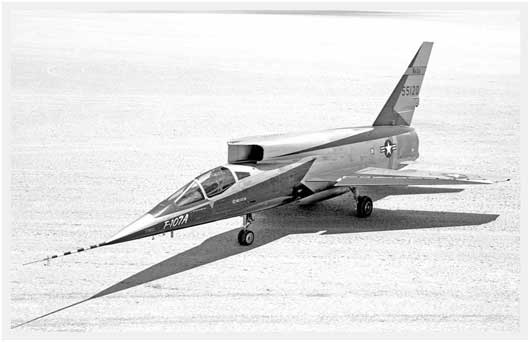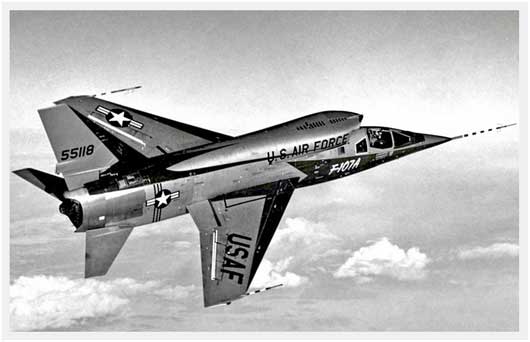CoolPix - Modern Military: North American F-107 'Man Eater'
 Wednesday, December 22, 2010 at 10:59AM
Wednesday, December 22, 2010 at 10:59AM  (click pic for hi-res) F-107A aircraft designed and built by North American in the mid 50's
(click pic for hi-res) F-107A aircraft designed and built by North American in the mid 50's
If you asked me about the F-107 before yesterday, all I'd really been able to tell you is that it's the one with the air intake oddly positioned right above and behind the cockpit. I've known of the existence of this airplane since I was a kid in the 70's, but I'd never paid any real attention to it. Well, I'm paying attention now, and wow, it was a pretty fascinating piece of work as a tactical fighter-bomber concept. As a quick side note, the first ever AirPigz Air Force Museum 'meet-up' (in Dayton, Ohio) is now tentatively scheduled for the weekend of January 29 and 30, and one of the three F-107's built is on display in the museum's Research & Development/Flight Test Gallery. Send me an email via this link for more info on getting in on this meet-up. It'll be a great way to have some avgeek fun (and education) in the middle of winter... and admission to the museum is free!
Back to the F-107. So, I wonder if the eject handle might actually have been labeled 'injest'... ok probably not. But still, having a massive inlet sucking huge amounts of air to feed a Pratt & Whitney J75 turbojet right behind your head is not the kind of thing you easily get used to. In the end, due to the F-105 Thunderchief from Republic being selected for the role of fighter-bomber, the F-107 never went past the stage of just three test aircraft, and thus never got an official name. Unofficially it was known as the Super Super Sabre or sometimes the Ultra Sabre, but pilots were more likely to call it the 'Man Eater'. And in case you're wondering, no one ever ejected from an F-107, so we never found out if there really was anything to worry about concerning becoming jet engine food!
The F-107 began its development as the F-100B, an outgrowth of the F-100 Super Sabre, but it wound up becoming pretty much a whole new airplane, so it eventually got the 107 designation. It was a noticeably larger airplane with much higher max speed, Mach 2+ compared to Mach 1.25 for the F-100. That top-mounted inlet was originally mounted below the cockpit, which itself was a departure from the hole-in-the-nose inlet of the F-100. But the Air Force wanted the airplane to be able to deploy a nuclear weapon that was to be carried partially up inside the bottom of the fuselage. Issues arose with the lower air intake creating a shockwave that caused problems with launching the nuclear weapon, which lead to a retrofit re-positioning. You might already know that the F-105 avoided all of these issues by having its air intake placed at the leading edge of the wing at the root, on both sides of the fuselage.
 (click pic for hi-res) North American F-107A in flight
(click pic for hi-res) North American F-107A in flight
Both of these CoolPix images of the F-107 are pretty awesome to study when you click the pic to make it big. The top pic, with the airplane sitting all alone on the dry lake-bed is my favorite. The combination of the unique and rather expansive cockpit windshield and canopy, along with the way the paint is designed (and even the way 'F-107' is painted on) seem to give it a sci-fi 'spaceship' kind of feel. Even with that intake placed where it is, there's something about this airplane that makes me think it would have been really interesting to fly.
I like how the bottom pic really shows how much glass was around the pilot. On one hand that's pretty cool from a sittin'-on-top-of-the-world stand point, but it also would make you think all the more about that very hungry intake tickling your ears! Bottom line: amazing aircraft and an amazing time in the aerospace industry.
The video below offers more interesting details... like the all moving vertical fin and the variable air inlet design. You can expect a lot more info from me on the F-107A in the future, and hopefully some really good pix of it at the Air Force Museum before long!














































































Reader Comments (8)
In re "man-eater" and ejection from F-107.
As you stated the point is moot - no ejection was demonstrated from the aircraft, and I can find no images of any F-107 sled tests by NAA at Edwards or Hurricane Mesa. Perhaps NAA was planning seat qualification tests at a later date.
However, the physics of the ejection process work against any ingestion of the pilot and seat into the F-107 intake. Having spent many hours viewing high-speed imaging of egress tests at Holloman, the seat-man combination translates along the seat rail plane for the first couple of feet of free-flight travel after seat tip-off (the point where the seat is free of the rail system as it translates upward.) This phenomenon holds true whether the seat is equipped with a rocket catapult or not.
Since the F-107's were developmental airplanes, they were almost certainly fitted with NAA F-100 seats, and these were gun catapult seats, not rocket catapults seen in more modern seats.
Most modern seats (in the West) are limited to 600 KEAS on a structural basis. At that speed he pilot is exposed to almost 9 pounds force per square inch dynamic pressure at that speed. (9 lbf/sq in x 144 sq in/ ft x 10 sq ft = 12,960 lb force!) and even with the ~13,000 pounds of aerodynamic force, the seats only travel aft a couple of inches by the time the bottom of the seat is 6 feet above the seat rails (this takes about 1/4 second). (Hoerner's book on Fluid Dynamic Drag, Section 13-22, gives a good description of the flight path expected by the seat)
So, was the F-107 a man-eater? Nope. Did it make a good story at the club, trying to impress a female? You bet!
PS, I enjoy the blog, keep it up!
JD- Thanx for the great comment. I understand your point about the slow initial deceleration of the pilot and ejection seat in relation to the rapid ascent away from the aircraft... I'll have to see if I can find some good videos or pictures on that for posting in the future. I did happen to run across a pic yesterday of what appears to be and F-107 cockpit sled, with the upper air intake mounted, on rails: F-107 Sled Test
It's interesting to note however that any tests done with this rig wouldn't account for the potential of the J75 running at full power and pulling large amounts of air... tho as you've pointed out, it likely still wouldn't have been a 'real' issue. It would be fascinating to know for sure tho! Lastly, I still imagine a pretty powerful psychological element at play just constantly knowing that the intake is where it is.
Thanx again, and I'm glad to see you like AirPigz : )
If I remember correctly, I believe this is one of the aircraft where the ejection seat shot the pilot down, and not up, because of the intake.
Matt,
Wow! I enjoyed the pic of the F-107 sled at Edwards (the background gives it away).
Your comment on the intake not fully simulating the airflow because the engine is not pulling in air is a common misconception. Often, the Aero guys will simply fair-over the inlets on wind tunnel models because when the engine is running at design (that is the air intake mass flow rate is optimal) the air that is not pulled in to the inlet acts as though the inlet was indeed faired- over! The point of having the inlet simulated on a sled test is to provide representative flow-field pressures near the cockpit and in the case of the F-107, to provide a physical obstacle that the seat must clear.
The issue of providing representative flow-field pressures near the cockpit is more for the canopy removal team than the seat troops. This looks cool, but could have been simulated by nothing more than a flat piece of metal (properly sized and flat face toward the front of the sled) in lieu of the inlet mock-up to provide an obstacle for the on-coming air.
I've seen the F-107 at Pima but do not recall seeing detonation cord in the transparency. So, was the canopy to be jettisoned (as was typical of the day) or shattered by det cord?
There is an image on the web of the F-22 sled at Holloman showing the engine inlets in place, but open at the back. Again this is to provide representative flow-field pressures near the cockpit.
Cheers
JD- It's funny you mention the air flow issue... I was thinking it thru when I posted my response, and I wondered if what you are saying might be the case. I haven't been exposed to such things, but it does make sense. However, I also was thinking that in a slow flight condition when full power is rapidly applied, there must be some element to the massive airflow thru the intake. That might make for an undesirable time to have to make a rapid exit : ) But again, it still might not have any noticeable affect on a blasted ejection seat.
Thanx again for the comment, I appreciate it!
I remember Aurora had a kit of it. This was around 1964 or so. And it was in the low cost line for grade school kids to build.
There was no detonating cord on this canopy - the canopy was to be ejected off first in the ejection process. The pilot/seat was launched normally, and not through the floor, using a NAA design seat, which I've read was the norm for that time. This was done for a short while on the F-104s I believe, but NOT on the F-107A. There ARE pics out there on the web of sled tests that were performed. There is also a DVD that shows the ejection seat firing process, performed at the factory. Thanks!
lorygitel e3d3fd1842 https://www.afrogoatinc.com/diadepactdous